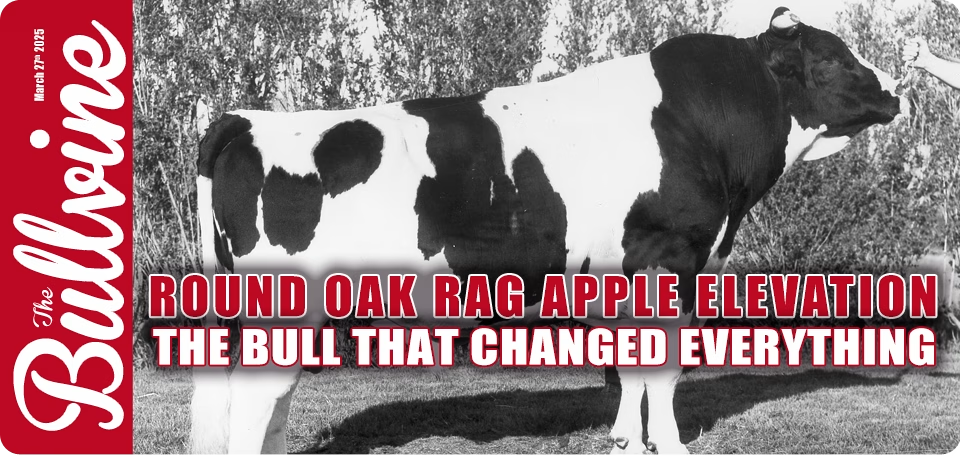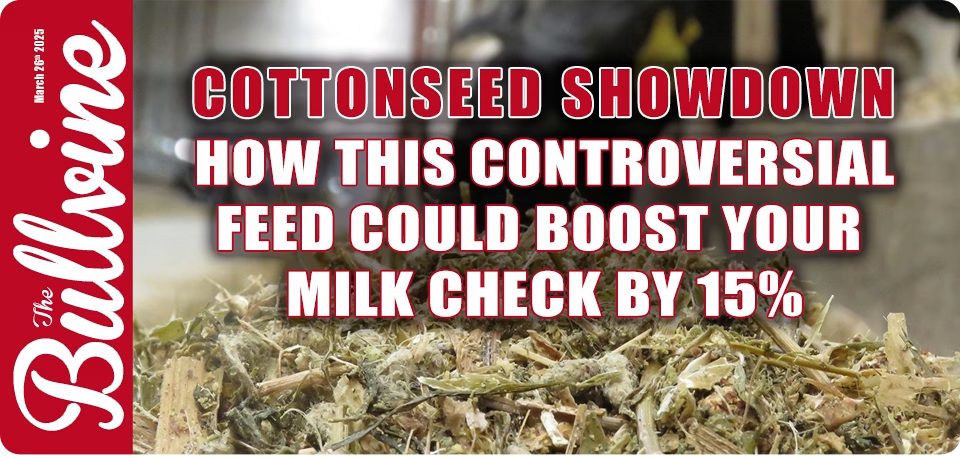Latest News
 Canadian Sire Lists Showcase Major Shifts in April 2025 EvaluationsThe April 2025 genetic evaluations have arrived, bringing significant changes across both genomic and daughter-proven Holstein sire lists in Canada. These evalu […]
Canadian Sire Lists Showcase Major Shifts in April 2025 EvaluationsThe April 2025 genetic evaluations have arrived, bringing significant changes across both genomic and daughter-proven Holstein sire lists in Canada. These evalu […] April 2025 Sire Evaluations: Scandinavian Holstein Rankings Reveal New LeadersThe April 2025 genetic evaluations for Scandinavian Holstein bulls have been released, showcasing significant movements in both proven and genomic sire categori […]
April 2025 Sire Evaluations: Scandinavian Holstein Rankings Reveal New LeadersThe April 2025 genetic evaluations for Scandinavian Holstein bulls have been released, showcasing significant movements in both proven and genomic sire categori […] Italian Holstein Evaluations: April 2025 Update Reveals Significant Changes in Bull RankingsThe April 2025 Italian Holstein evaluations have been released. They showcase notable shifts in proven and genomic bull rankings since the December 2024 evaluat […]
Italian Holstein Evaluations: April 2025 Update Reveals Significant Changes in Bull RankingsThe April 2025 Italian Holstein evaluations have been released. They showcase notable shifts in proven and genomic bull rankings since the December 2024 evaluat […] Record-Breaking “Party at the Polo” Sale: Tahora Pony Fetches $77,000 as Dairy Elite Command Premium PricesThe picturesque Tahora Farms in Canterbury, New Zealand transformed into the dairy industry's hottest destination last weekend as nearly 500 enthusiasts gathere […]
Record-Breaking “Party at the Polo” Sale: Tahora Pony Fetches $77,000 as Dairy Elite Command Premium PricesThe picturesque Tahora Farms in Canterbury, New Zealand transformed into the dairy industry's hottest destination last weekend as nearly 500 enthusiasts gathere […]Why Your Milk’s Rehydration Properties Matter: The Science of High-Protein Dairy Powders
Discover why your milk’s ability to dissolve matters more than ever. New research on high-protein dairy powders reveals surprising challenges that could impact […]
More News
- 5 Technologies That Will Make or Break Your Dairy Farm in 2025
- Beef-Dairy Crossbreds: The Feed Efficiency Revolution Rewriting Dairy Costs
- How Forward-Thinking Dairy Producers Will Not Only Survive but Thrive in 2025
- MAHA: A Double-Edged Sword for the Dairy Industry
- 2025 U.S. Genetic Base Change: Final Values and Strategic Implications
- UK Holstein Scene Celebrates Another EX97 Star: Riverdane Chief Lila Z Makes History!
- Heat, Herds, and Profits: Beating the Milk Production Crisis
- Genetic Game-Changer: How 115 Genes Could Save Dairy Farmers Millions in TB Losses
- Australia’s Dairy Crisis: Tough Truths Behind 2025’s Production Decline
- Cage-Free Backlash: Are We Sacrificing Hens or Profit Margins?
Top News Posts from Past Week
- Genetic Revolution: How Record-Breaking Milk Components Are Reshaping Dairy’s Future
- Australia’s Dairy Crisis: Tough Truths Behind 2025’s Production Decline
- Mega-Dairy Revolution: Inside the World’s 10 Largest Dairy Farms
- UK Holstein Scene Celebrates Another EX97 Star: Riverdane Chief Lila Z Makes History!
- The $1,200 Heifer Paradox: Why Your Healthiest Cows May Produce Your Worst Replacements
- H5N1 Strikes Again: Minnesota Dairy Farm Reinfected
- 2025 U.S. Genetic Base Change: Final Values and Strategic Implications
- MAHA: A Double-Edged Sword for the Dairy Industry
- CHINA SLAMS DOOR ON U.S. BEEF: Your Cull Cow Checks Could Take a Massive Hit
- A Father’s Final Legacy: What Reed Hostetler’s Tragic Loss Can Teach Every Dairy Farm
Feature Articles
Northeast Spring National Holstein Show 2025
March 31st, 2025 @ Hamburg, NY E217 Northeast Spring National Holstein Show 2025 | RSS.com The New York Spring Holstein Show, judged by Ryan Krohlow, showcased […]When Cows Were Kings: Revisiting Carnation’s Golden Age of Dairy Breeding
How the 1900s 'contented cows' sparked a dairy revolution: Carnation Farms blended animal welfare with cutting-edge science to create genetics that still shape […]BEEF-ON-DAIRY REVOLUTION: Former Dairy Farmers Finding Gold in the Beef Market Corporate Giants Overlooked
While mega-dairies grabbed headlines, small farmers quietly hijacked beef genetics – creating a stealth revolution corporate giants never saw coming. E214 BEEF- […]BST Reapproval: The Key to Unlocking Dairy Sustainability
BST: Dairy’s Controversial Climate Hero? Discover how this taboo tech slashes emissions and boosts efficiency—plus why the industry’s sustainability future hing […]Round Oak Rag Apple Elevation: The Bull That Changed Everything
Born from an unlikely mating, one bull revolutionized global dairy breeding with genetics so powerful they still dominate herds 60 years later. E212 Round Oak R […]
More Articles
- Cottonseed Showdown: How This Controversial Feed Could Boost Your Milk Check by 15%
- Making Dreams Come True: The Journey of Tom & Kelli Cull
- The Great Holstein Shakeup: How 16 Years Rewrote Breeding Rules
- Michael Heath’s Enduring Legacy: How One Man’s Passion Redefined Dairy Excellence
- How Smart Dairy Farmers Are Slashing Methane While Boosting Profits
- The Cow That Built an Empire: Comestar Laurie Sheik’s Unstoppable Genetic Legacy
- Bird Flu Bombshell: Dairy Cows Losing a Full Ton of Milk with No Recovery
- GENETIC GIANTS DETHRONED: How Dairy Farmers and Beef Upstarts Hijacked 75% of the Beef-on-Dairy Gold Rush
- Bull in a China Shop: How Juan Moreno Turned the Dairy World Upside Down
- Transform Your Dairy Economics: How Beef-on-Dairy Crossbreeding Delivers 200% ROI
Top Feature Articles from the Past Month
- Top 15 Best Milk Brands in the USA: Unveiling the Cream of the Crop
- 10 Sires To Breed The Next World Dairy Expo Grand Champion
- The Cow That Built an Empire: Comestar Laurie Sheik’s Unstoppable Genetic Legacy
- Why Donald Trump Hates Canada’s Dairy Supply System
- Northeast Spring National Holstein Show 2025
- Making Dreams Come True: The Journey of Tom & Kelli Cull
- CAPTAIN: The Bull That Rewrote the Rules for Modern Breeding
- The $4,300 Gamble That Reshaped Global Dairy Industry: The Pawnee Farm Arlinda Chief Story
- From Pasture to Powerhouse: The GenoSource Story
- FROM TRAGEDY TO TRIUMPH: The Unstoppable Journey of Holstein Legend Nico Bons
- Northeast Spring National Holstein Show 2025
-
Northeast Spring National Holstein Show 2025
Andrew Hunt Mar 31, 2025March 31st, 2025 @ Hamburg, NY E217 Northeast Spring National Holstein Show 2025 | RSS.com The New York Spring Holstein Show, judged by Ryan Krohlow, showcased exceptional dairy cattle across multiple age divisions. The competition featured remarkable depth of quality throughout,… Read More - When Cows Were Kings: Revisiting Carnation’s Golden Age of Dairy Breeding
-
When Cows Were Kings: Revisiting Carnation’s Golde…
Andrew Hunt Mar 30, 2025How the 1900s 'contented cows' sparked a dairy revolution: Carnation Farms blended animal welfare with cutting-edge science to create genetics that still shape modern herds. E216 When Cows Were Kings: Revisiting Carnation’s | RSS.com A Pastoral Legacy: Holstein dairy cattle graze peacefully… Read More
- BEEF-ON-DAIRY REVOLUTION: Former Dairy Farmers Finding Gold in the Beef Market Corporate Giants Overlooked
-
BEEF-ON-DAIRY REVOLUTION: Former Dairy Farmers Fin…
Andrew Hunt Mar 29, 2025While mega-dairies grabbed headlines, small farmers quietly hijacked beef genetics – creating a stealth revolution corporate giants never saw coming. E214 BEEF-ON-DAIRY REVOLUTION: Former Dairy Farmer | RSS.com The dairy establishment missed it completely. While industry leaders were busy bui… Read More
- BST Reapproval: The Key to Unlocking Dairy Sustainability
-
BST Reapproval: The Key to Unlocking Dairy Sustain…
Andrew Hunt Mar 28, 2025BST: Dairy’s Controversial Climate Hero? Discover how this taboo tech slashes emissions and boosts efficiency—plus why the industry’s sustainability future hinges on embracing it. E213 BST Reapproval: The Key to Unlocking Dairy Su | RSS.com The future of dairy farming is facing a critical mom… Read More
- Round Oak Rag Apple Elevation: The Bull That Changed Everything
-
Round Oak Rag Apple Elevation: The Bull That Chang…
Andrew Hunt Mar 27, 2025Born from an unlikely mating, one bull revolutionized global dairy breeding with genetics so powerful they still dominate herds 60 years later. E212 Round Oak Rag Apple Elevation: The Bull That | RSS.com Round Oak Rag Apple Elevation (1965-1979), the legendary Holstein sire dubbed “Bull of t… Read More
- Cottonseed Showdown: How This Controversial Feed Could Boost Your Milk Check by 15%
-
Cottonseed Showdown: How This Controversial Feed C…
Andrew Hunt Mar 26, 2025Controversial feed boosts milk checks by 15%? New research reveals how whole cottonseed could be your dairy profit game-changer! E211 Cottonseed Showdown: How This Controversial F | RSS.com Forget what you've heard about cottonseed risks—new research published in the Journal of Dairy Science… Read More
- Making Dreams Come True: The Journey of Tom & Kelli Cull
-
Making Dreams Come True: The Journey of Tom &…
Karen Hunt Mar 25, 2025From small farms to industry legends: How Tom & Kelli Cull’s grit, innovation, and "Never Give Up" mantra turned Budjon Farms into a dairy dynasty. E210 Making Dreams Come True: The Journey of Tom & | RSS.com Have you ever met someone whose passion is so infectious that you want to drop e… Read More
- The Great Holstein Shakeup: How 16 Years Rewrote Breeding Rules
-
The Great Holstein Shakeup: How 16 Years Rewrote B…
Murray Hunt Mar 24, 2025How Holstein breeding flipped from show-ring beauty to farm profitability: The 16-year revolution that's transforming dairy genetics forever. E208 The Great Holstein Shakeup: How 16 Years Rewr | RSS.com Do you know what blows my mind? How completely different Holstein breeding looks today com… Read More
- Michael Heath’s Enduring Legacy: How One Man’s Passion Redefined Dairy Excellence
-
Michael Heath’s Enduring Legacy: How One Man’s Pas…
Andrew Hunt Mar 23, 2025Two years gone, but his legacy thrives: How Michael Heath's unparalleled eye for cattle and generous spirit continue to shape the dairy industry today. E207 Michael Heath’s Enduring Legacy: How One Man’ | RSS.com It's hard to believe it's been two years since we lost him. I can't help but ref… Read More
- How Smart Dairy Farmers Are Slashing Methane While Boosting Profits
-
How Smart Dairy Farmers Are Slashing Methane While…
Andrew Hunt Mar 22, 2025Climate zealots call your cows climate criminals, but savvy dairy farmers are turning methane reduction into cold, hard cash. Here's how they're doing it. E206 How Smart Dairy Farmers Are Slashing Methane | RSS.com The climate crusaders have dairy in their crosshairs, but savvy farmers aren'… Read More
Tanbark Trail
Northeast Spring National Holstein Show 2025
March 31st, 2025 @ Hamburg, NY E217 Northeast Spring National Holstein Show 2025 | RSS.com The New York Spring Holstein Show, judged by Ryan Krohlow, showcased exceptional dairy cattle across multiple age divisions. The competition featured remarkabl […]Is Erbacers Snapple Shakira One of the Greatest Show Cows of All Time?
Uncover why Erbacres Snapple Shakira stands among the top dairy show cows of all time. What makes her excel in the competitive dairy arena? E55 Is Erbacers Snapple Shakira One of the Greatest Show Cows of All Time? From the moment she steps into the […]The Royal Winter Fair 2024 – Jersey
Judge Jeff Sales NTENSE JOEL DELPHIE ETGrand ChampionThe Royal - Jersey Show 2024WEEKSDALE/HI-CALIBER/ROCK ALLEN/F&D BORBA, BREADALBANE, PE c LEACHLAND VIDEO MOCHA K Intermediate Champion The Royal - Jersey Show 2024 WEEKSDALE HOLSTEINS, BRE […]The Royal Winter Fair 2024 – Holstein
Judge Blair Weeks JEFFREY-WAY HARD ROCK TWIGS Grand Champion The Royal - Holstein Show 2024 K. DOEBERIENER, L. BOWEN & PAT CONROY, R&F LIVESTOCK INC, & WALKER DAIRY INC. Grand Champion: Jeffrey-Way Hard Rock Twigs, 1st 4-year-old, K Doebe […]The Royal Winter Fair 2024 – Red & White Holstein
November 4th 2024 Judge: Markus Hehli, Rimbey, AB PREMIUM APPLE CRISP LILLY Grand Champion The Royal - Red & White Holstein Show BUTLERVIEW FARM, CHEBANSE, IL Grand Champion: Premium Apple Crisp Lilly (Apple-Crisp), 1st 5-year-old, Butlerview Far […]
The Bullvine LLC © 2025 | Terms of Use | Community Guidelines | Privacy Policy |
Manage Consent
To provide the best experiences, we use technologies like cookies to store and/or access device information. Consenting to these technologies will allow us to process data such as browsing behavior or unique IDs on this site. Not consenting or withdrawing consent, may adversely affect certain features and functions.
Functional Always active
The technical storage or access is strictly necessary for the legitimate purpose of enabling the use of a specific service explicitly requested by the subscriber or user, or for the sole purpose of carrying out the transmission of a communication over an electronic communications network.
Preferences
The technical storage or access is necessary for the legitimate purpose of storing preferences that are not requested by the subscriber or user.
Statistics
The technical storage or access that is used exclusively for statistical purposes.
The technical storage or access that is used exclusively for anonymous statistical purposes. Without a subpoena, voluntary compliance on the part of your Internet Service Provider, or additional records from a third party, information stored or retrieved for this purpose alone cannot usually be used to identify you.
Marketing
The technical storage or access is required to create user profiles to send advertising, or to track the user on a website or across several websites for similar marketing purposes.

























